Year :
2009
Title :
Biology
Exam :
JAMB Exam
Paper 1 | Objectives
41 - 50 of 50 Questions
| # | Question | Ans |
|---|---|---|
| 41. |
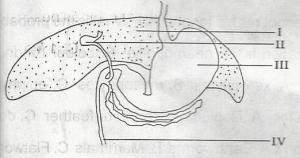 Use the diagram above to answer this question. A. neutral B. alkaline C. acidic D. saline Detailed SolutionStomach acid's low pH level is largely attributable to one ingredient: hydrochloric acid (HCl).There is an explanation video available below. |
|
| 42. |
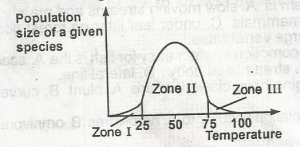 Use the diagram above to answer this question. A. l and ll B. ll only C. ll and lll D. l and lll Detailed SolutionPhysiological stress can be defined as any external or internal condition that challenges the homeostasis of a cell or an organism.It can be divided into three different aspects: environmental stress, intrinsic developmental stress, and aging. That zone is option D There is an explanation video available below. |
|
| 43. |
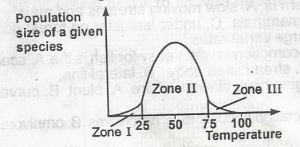 Use the diagram above to answer this question. A. 25oC B. 50oC C. 75oC D. 100oC |
|
| 44. |
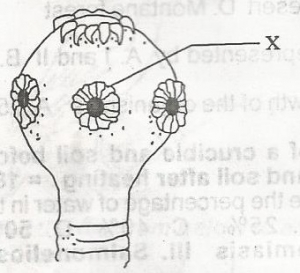 In the diagram, the structure labelled X is for? A. attachment B. feeding C. seeing D. breathing Detailed Solutionsuckers are the organs of attachment to the host tissues.There is an explanation video available below. |
|
| 45. |
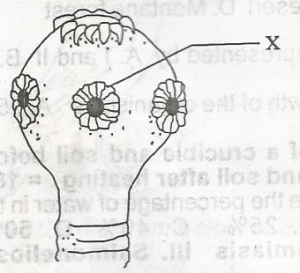 In the diagram, the habitat of the organism is A. slow moving streams and marshes B. the stomach of large mammals C. under leaf filter on forest floor D. the small intestine of large vertebrates Detailed SolutionTapeworms generally inhabit the intestines of humans and animals. They have a series of hooks (or suckers) on one end that they use to attach to the intestine to get nourishment from the host.There is an explanation video available below. |
|
| 46. |
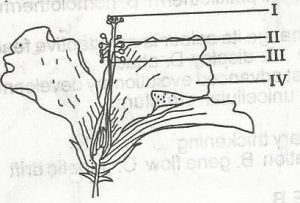 In the diagram, the male sex cells are contained in the part labelled? A. i B. ii C. iii D. iv Detailed SolutionStamens are the male reproductive organs of flowering plants.They consist of an anther, the site of pollen development, and in most species a stalk-like filament, which transmits water and nutrients to the anther and positions it to aid pollen dispersal There is an explanation video available below. |
|
| 47. |
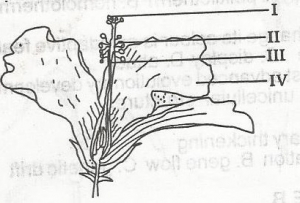 In the diagram, the likely pollinating agent of the flower is? A. wind B. water C. insect D. man Detailed Solutionadaptations of entomophilous / insected pollinated flowers are the following;There is an explanation video available below. |
|
| 48. |
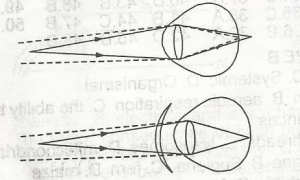 In the diagram, the eye defect illustrated is? A. myopia B. hypermetropia C. astigmaism D. cataract Detailed SolutionLong-sightedness affects the ability to see nearby objects. You may be able to see distant objects clearly, but closer objects are usually out of focus.It can be corrected by using convex lens There is an explanation video available below. |
|
| 49. |
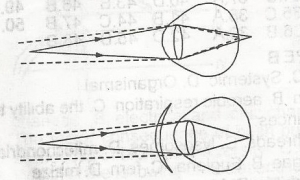 In the diagram, the function of the correcting lens is to? A. diverge incoming rays B. converge incoming rays C. reflect incoming rays D. screen incoming rays Detailed SolutionThe simplest, cheapest and safest way to correct long sight is with glasses.Convex prescription lenses (called plus lenses) are used to bend light rays slightly inwards / converge them to give a little bit of additional focusing power to the eye. There is an explanation video available below. |
|
| 50. |
Chewing the cud is an adaptation peculiar to? A. Herbivores B. Omnivores C. Rodents D. Ruminants Detailed SolutionCud chewing is also necessary because the foods ruminant animals eat are difficult to digest and it takes extra effort to get all of the nutrients from the food.Other examples of ruminant animals include deer, camels, buffalo, goats, sheep, and giraffes. The main difference between ruminant and non-ruminant animals is that ruminant animals are herbivores whereas non-ruminant animals are omnivores or carnivores. Thus, ruminant animals have a complex rumen to digest plant material while non-ruminant animals have a simple stomach since their food is easy to digest. Non-ruminant animals are animals with a single-compartment stomach, such as swine, poultry, horses, dogs, cats, and humans. There is an |
| 41. |
 Use the diagram above to answer this question. A. neutral B. alkaline C. acidic D. saline Detailed SolutionStomach acid's low pH level is largely attributable to one ingredient: hydrochloric acid (HCl).There is an explanation video available below. |
|
| 42. |
 Use the diagram above to answer this question. A. l and ll B. ll only C. ll and lll D. l and lll Detailed SolutionPhysiological stress can be defined as any external or internal condition that challenges the homeostasis of a cell or an organism.It can be divided into three different aspects: environmental stress, intrinsic developmental stress, and aging. That zone is option D There is an explanation video available below. |
|
| 43. |
 Use the diagram above to answer this question. A. 25oC B. 50oC C. 75oC D. 100oC |
|
| 44. |
 In the diagram, the structure labelled X is for? A. attachment B. feeding C. seeing D. breathing Detailed Solutionsuckers are the organs of attachment to the host tissues.There is an explanation video available below. |
|
| 45. |
 In the diagram, the habitat of the organism is A. slow moving streams and marshes B. the stomach of large mammals C. under leaf filter on forest floor D. the small intestine of large vertebrates Detailed SolutionTapeworms generally inhabit the intestines of humans and animals. They have a series of hooks (or suckers) on one end that they use to attach to the intestine to get nourishment from the host.There is an explanation video available below. |
| 46. |
 In the diagram, the male sex cells are contained in the part labelled? A. i B. ii C. iii D. iv Detailed SolutionStamens are the male reproductive organs of flowering plants.They consist of an anther, the site of pollen development, and in most species a stalk-like filament, which transmits water and nutrients to the anther and positions it to aid pollen dispersal There is an explanation video available below. |
|
| 47. |
 In the diagram, the likely pollinating agent of the flower is? A. wind B. water C. insect D. man Detailed Solutionadaptations of entomophilous / insected pollinated flowers are the following;There is an explanation video available below. |
|
| 48. |
 In the diagram, the eye defect illustrated is? A. myopia B. hypermetropia C. astigmaism D. cataract Detailed SolutionLong-sightedness affects the ability to see nearby objects. You may be able to see distant objects clearly, but closer objects are usually out of focus.It can be corrected by using convex lens There is an explanation video available below. |
|
| 49. |
 In the diagram, the function of the correcting lens is to? A. diverge incoming rays B. converge incoming rays C. reflect incoming rays D. screen incoming rays Detailed SolutionThe simplest, cheapest and safest way to correct long sight is with glasses.Convex prescription lenses (called plus lenses) are used to bend light rays slightly inwards / converge them to give a little bit of additional focusing power to the eye. There is an explanation video available below. |
|
| 50. |
Chewing the cud is an adaptation peculiar to? A. Herbivores B. Omnivores C. Rodents D. Ruminants Detailed SolutionCud chewing is also necessary because the foods ruminant animals eat are difficult to digest and it takes extra effort to get all of the nutrients from the food.Other examples of ruminant animals include deer, camels, buffalo, goats, sheep, and giraffes. The main difference between ruminant and non-ruminant animals is that ruminant animals are herbivores whereas non-ruminant animals are omnivores or carnivores. Thus, ruminant animals have a complex rumen to digest plant material while non-ruminant animals have a simple stomach since their food is easy to digest. Non-ruminant animals are animals with a single-compartment stomach, such as swine, poultry, horses, dogs, cats, and humans. There is an |